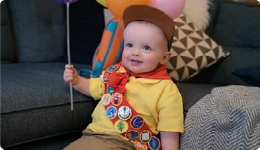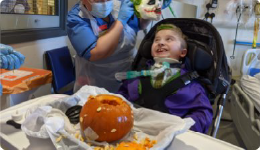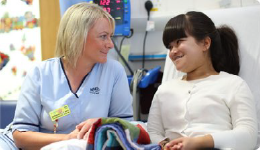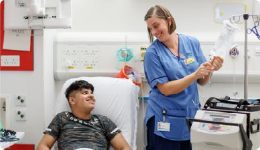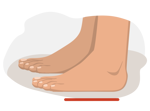 The ankle joint connects the foot to the lower leg. It is surrounded by various muscles and ligaments, which give it stability.
The ankle joint connects the foot to the lower leg. It is surrounded by various muscles and ligaments, which give it stability.
Ankle problems are fairly common. They can also cause pain in the foot. Ankle problems often get better with time and do not usually cause any long term issues.
If your child rolls, twists or turns on their ankle in an awkward way this can lead to a soft tissue injury. It can stretch or tear the tough bands of tissue (ligaments) that help hold the ankle bones together.
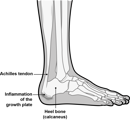 Sever's is a common cause of heel pain in children and adolescents, between the ages of 8-14. It is most common in very active children/young people and/ or those who have had a recent growth spurt. Tight calf muscles or the Achilles tendon (the tendon which attaches the calf muscle to the heel bone) cause the pain. There is 'pulling' where it attaches to the heel. It can be painful to touch and sore on activity; such as running and jumping or with prolonged walking. Wearing flat shoes can also be a cause. Sometimes Sever's can cause limping, walking on toes, and or some swelling around the heel. It can occur in one or both heels. Sever's gets better with a period of rest and doing less high impact activities. Ice packs can be used for pain and swelling. Well-fitting footwear is important.
Sever's is a common cause of heel pain in children and adolescents, between the ages of 8-14. It is most common in very active children/young people and/ or those who have had a recent growth spurt. Tight calf muscles or the Achilles tendon (the tendon which attaches the calf muscle to the heel bone) cause the pain. There is 'pulling' where it attaches to the heel. It can be painful to touch and sore on activity; such as running and jumping or with prolonged walking. Wearing flat shoes can also be a cause. Sometimes Sever's can cause limping, walking on toes, and or some swelling around the heel. It can occur in one or both heels. Sever's gets better with a period of rest and doing less high impact activities. Ice packs can be used for pain and swelling. Well-fitting footwear is important.
Stretching of the calf muscles if they are tight, and it is not sore to do so, can also help. Sever's can take a few weeks and up to a few months to settle. It does not cause any long term damage, but it can recur until growing stops.
For more information and advice look at:
- Sever's Disease leaflet from NHSGGC
- Sever's / Calcaneal Apophysitis leaflet from the Association of Paediatric Chartered Physiotherapists (APCP)
- Choosing Footwear for Children from the Association of Paediatric Chartered Physiotherapists (APCP)
- Advice on physical activity and participation
When to seek help:
- There has been significant trauma
- The ankle is misshapen/swollen
- The calf is hot, swollen and tender
- Your child has difficulty putting weight on their leg (limping)
- The pain is worsening/constant/disturbing their sleep
- They have significant weight loss
- There is stiffness first thing in the morning
- They feel unwell and/or have a high temperature (fever)


 Hamstring Stretch
Hamstring Stretch  The knee’s main job is to bend, straighten and take the weight of the body along with the ankles and hips. The knee is made up of bones, ligaments, tendons and cartilage. Knee pain is common in children and young people. It is usually due to growth and changes to their body as they mature.
The knee’s main job is to bend, straighten and take the weight of the body along with the ankles and hips. The knee is made up of bones, ligaments, tendons and cartilage. Knee pain is common in children and young people. It is usually due to growth and changes to their body as they mature.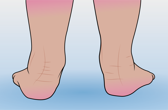 Flat feet can often be seen in babies starting to stand or toddlers and young children. The arches of the foot may not develop until the child is 4-5 years of age. This is normal.
Flat feet can often be seen in babies starting to stand or toddlers and young children. The arches of the foot may not develop until the child is 4-5 years of age. This is normal.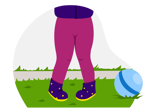 Intoeing
Intoeing Intoeing is more common in children who 'W' sit. Encourage your child to sit with their legs in a basket, out in front of them or tucked to the side. Intoeing tends to happen on both sides. It usually resolves by 8-10 years of age.
Intoeing is more common in children who 'W' sit. Encourage your child to sit with their legs in a basket, out in front of them or tucked to the side. Intoeing tends to happen on both sides. It usually resolves by 8-10 years of age. Toe walking is walking on tip toes or when the heel doesn't touch the ground. It can happen some, most or all of the time. Toe walking is a normal part of development and lots of children grow out of this. In some cases toe walking can continue into adulthood. Toe walking can sometimes be due to other conditions like cerebral palsy, muscular dystrophy or neurodevelopmental differences like autism.
Toe walking is walking on tip toes or when the heel doesn't touch the ground. It can happen some, most or all of the time. Toe walking is a normal part of development and lots of children grow out of this. In some cases toe walking can continue into adulthood. Toe walking can sometimes be due to other conditions like cerebral palsy, muscular dystrophy or neurodevelopmental differences like autism.
